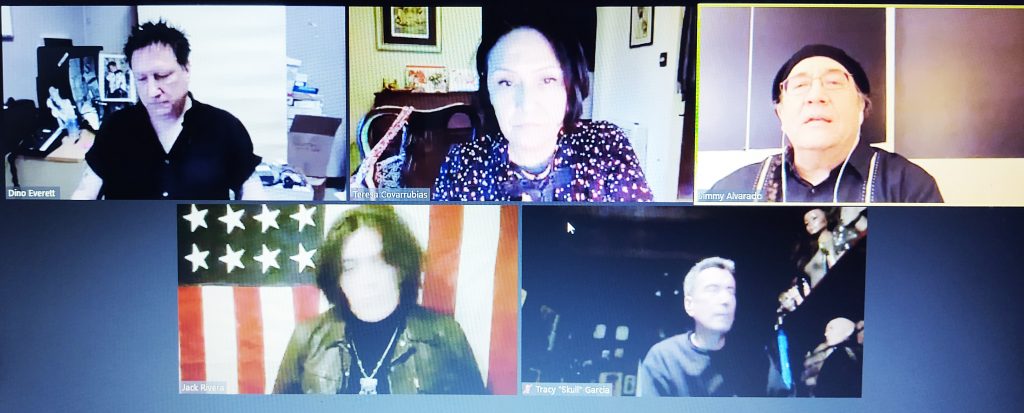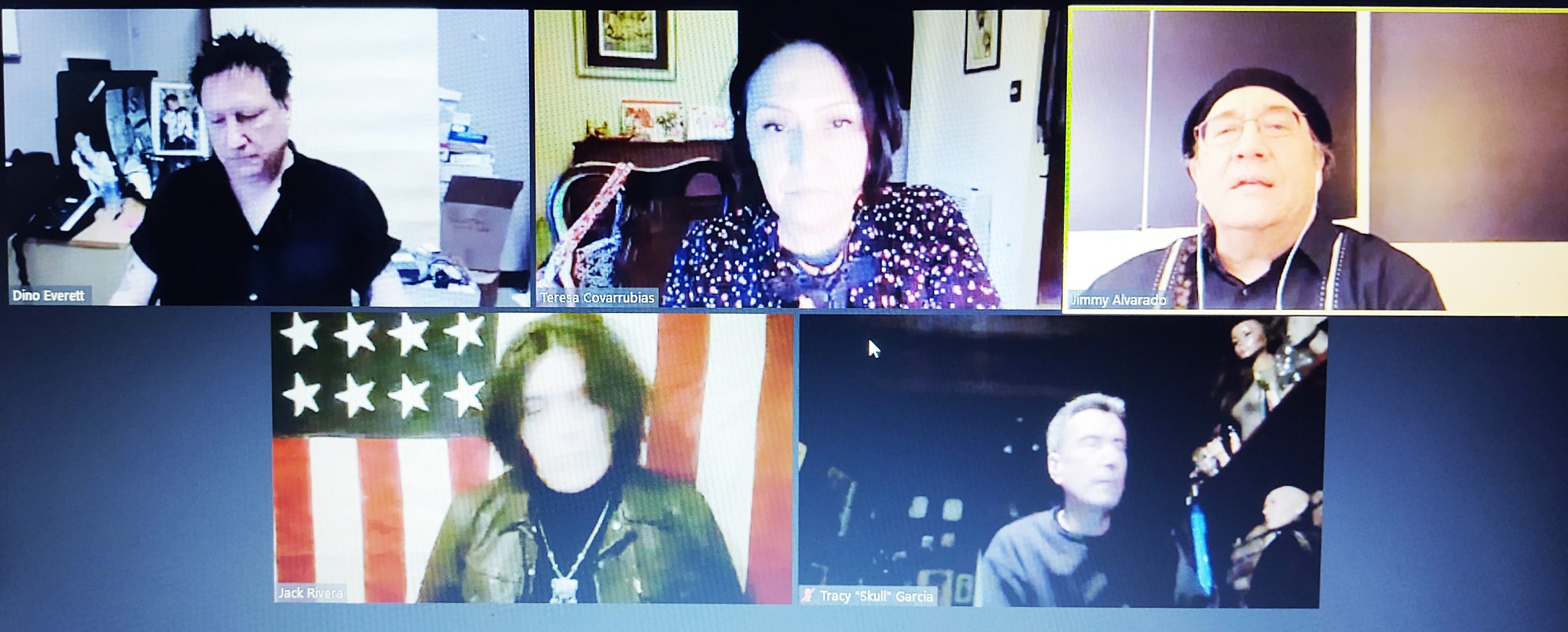By Keith Walsh
The punk rock scene coming of out of East Los Angeles in the late 1970s and early 1980s was the subject of discussion at a Zoom presentation by USC Visions and Voices on April 22. Presented by Dino Everett of USC, “Eastside Punks: A Screening And Conversation” featured East L.A. Punk alums Teresa Covarubbias (The Brat), Jack Rivera (The Stains) and Tracy “Skull” Garcia (Thee Undertakers) along with journalist and documentary filmmaker Jimmy Alvarado.
Alvarado, a reporter for RazorCake, created short documentary films honoring these three bands and others, including Nervous Gender, the pioneering punk project that challenged expectations by using synthesizers in punk music.
In the presentation, host Everett, a film archivist for USC, spoke to Alvarado and the three musicians about their experiences as artists from East LA playing in the new punk scene that started in and around Los Angeles in the late 1970s.

Backyard Parties
As Rivera of The Stains pointed out, the punk scene coming out of East LA was present at backyard parties even before The Hex nightclub opened. “There were no clubs or anything, for bands to play in,” said Rivera. “I guess these guys didn’t think they could break out and play Gazzari’s or whatever it was back in the late 70s for the rock bands. We’re talking when Van Halen was starting, 76, 77.”
Teresa of The Brat chimed in. “I remember, those were the first gigs I went to, were probably backyard shows where you pay five bucks, and you get all the beer you want. Yeah, those were fun.”
Tracy Garcia of Thee Undertakers said “I’m thinking a lot of other bands too, when we started, we did gigs with The Brat, high schools, backyard parties. Back before they got The Vex going, we did a show where, I told Jimmy, we had cans thrown at us. It was an underground place, it looked like where The Beatles played at in Germany, weird underground thing, The Stains, The Illegals, and The Undertakers. We didn’t really know each other then, we didn’t know what the hell we were doing, we were just playing, but this is before The Vex started. But a lot of it started in backyard parties. And going to backyard parties because like you said, there were no clubs. We’re bored. We were young kids.”
The Chicano Groove
Jack Rivera: “The first generation of East LA bands were really lucky, in that they had The Vex, and they had Rudy’s Pasta House, and like everybody else they started in the backyards, because that’s where you start. You can’t automatically start at The Whiskey as your first gig. In the case of the subsequent generations, once the interest was lost from that, the momentum from the original first wave was kind of lost, a lot of the attention that there was kind of dissipated and so that’s where my generation would have come in…. We said ‘well f### it, we’ll focus all of our attention on the backyards. We started this kind of weird little network of backyard shows. And that’s where we threw all of our focus in.”
“Subsequent generations have kind of built on that. We’ve finally moved our way out….Starting in the late 80s and 90s a lot of the bands from my generation started going into Al’s Bar and Silverlake Lounge and all of those places. What England had in terms of post punk we had in terms of Chicano Groove. And a lot of bands that were in Chicano Groove were a lot of the old punker kids that were playing in backyards. And I can tell you to a band what bands they were in because we used to play shows with them in the backyards. When we moved out there was another generation of bands that started playing the backyards. And they developed – you had Union, and you had Social Conflict, and Teenage Rage, and then they moved out and started playing clubs, and then there was a whole ‘nother generation and so on and so forth. I think the current one is Corrupted Youth is the big band in the backyards right now”
What Is Punk?
Teresa of The Brat – a band that started in East L.A. and got lots of attention in the early 80s playing for acts like Adam And The Ants and Bauhaus, had a lot to say about the punk community –what held it together and what threatened to tear it apart. “There was a time when you’d go to shows and you’d know everybody there, the people that would come in – it felt like a big family. It felt like everybody there knew everybody else. It was just a really great sense of community for a while. That was really nice. It didn’t last for very long, but that was a memory that I’ll always remember. And playing with other groups – playing with Los Illegals, or playing with Thee Undertakers and having a whole group of people at every show that was supporting that unity of people, was a memory that I like.”
“There was a lot of other stuff too that was not as nice, that I also remember as well” Covarrubias said. “I remember getting a lot of slag of people saying, ‘ well, you’re not punk,’ and making that judgment. For me, punk has not been a style of music, and it wasn’t really a way you looked or dressed, it was more an attitude that you brought, and it was this sense of that, of ‘I don’t give a sh##! You don’t think I’m punk, I don’t give a sh##. It was this idea of ‘I don’t care what anybody says, I do what I do, and I’m proud of what I do, and I know that I have this in me, and I’m bringing it out there, and you can take it or leave it, you can spit at it, or do whatever you want, and that’s punk.’ Punk is going out there and not being afraid of people saying sh@! about you. In my experience, I got a lot of that. I got a lot of that. I must say, at the time, it really cut me to my heart a lot of times with things that people would say. But I realize that just putting myself out there and just taking that abuse was very punk.”
Filmmaker Jimmy Alvarado made a great point when he said “and in the end you actually won out because your band is one of the most highly regarded bands in LA punk now. I don’t hear people thinking badly of that record, and that record is now regarded as a classic, and rightly so.” (Alvarado refers to The Brat’s “Attitudes” EP, a five song 10 inch disc from 1980.)
RazorCake on YouTube
The Brat
The Undertakers At Artifix Records
The Stains Official Facebook
Jimmy Alvarado At Razorcake
finis
